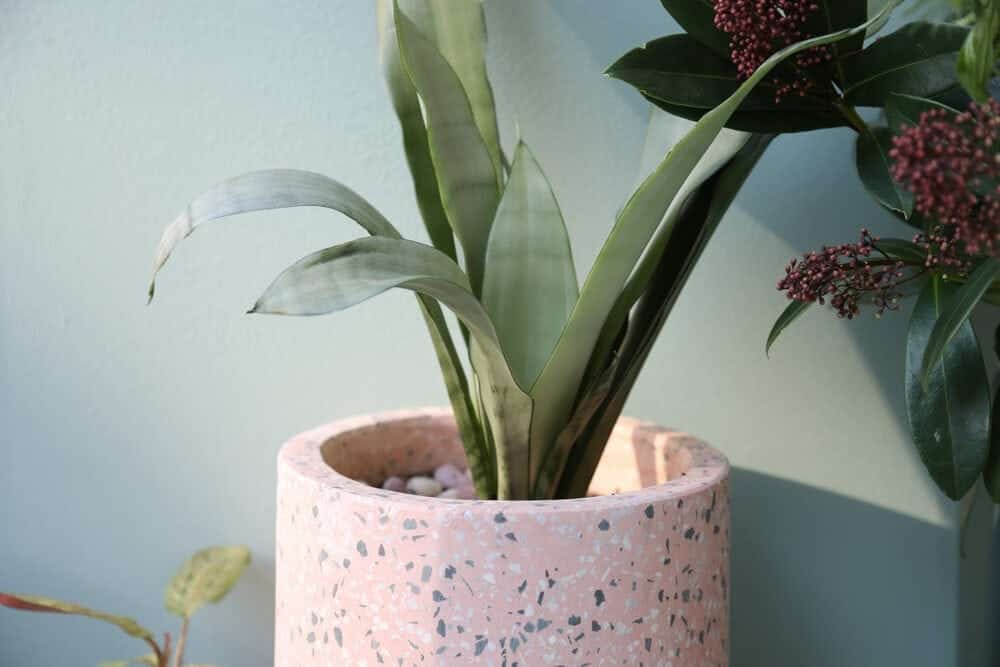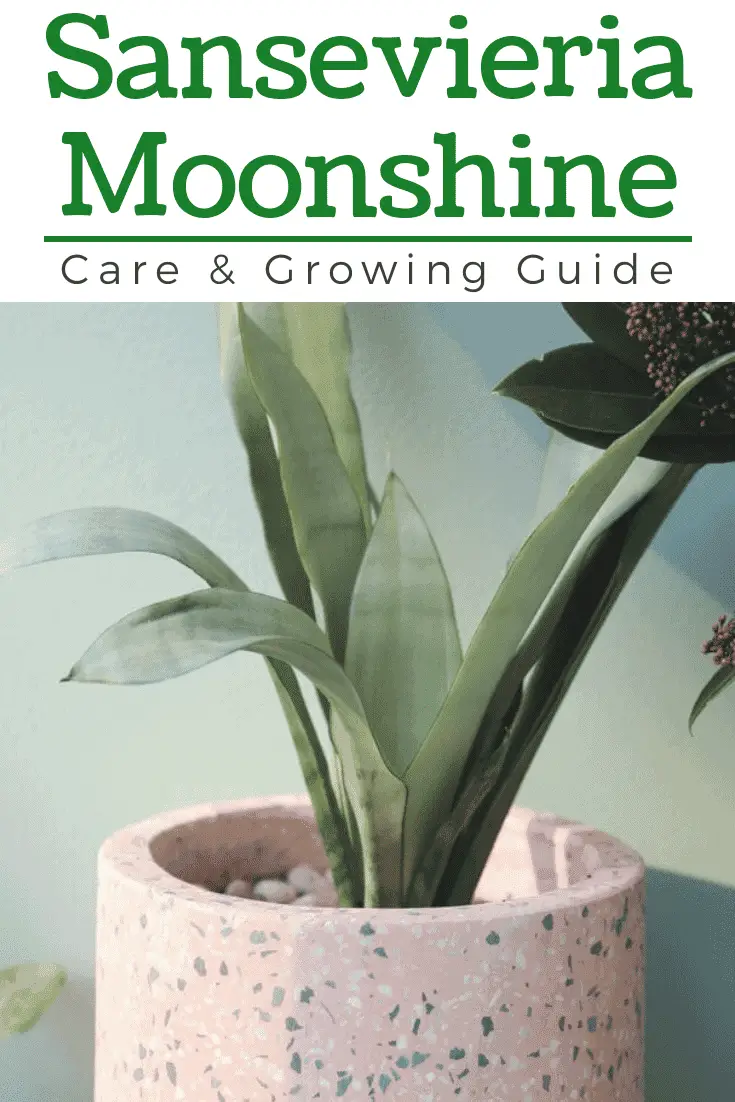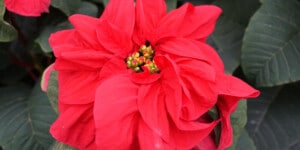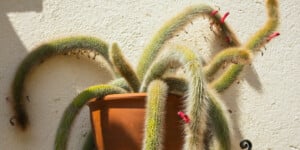Very few plants can survive a range of waterings, temperatures, and climate.
But this moonshine plant is just strong and sturdy enough to prosper whenever it is. This plant is excellent for people who have a hard time keeping their plants alive.
Sansevieria Moonshine Care & Growing Guide
1. Light requirements
The best type of light of the moonshine plant is bright but indirect light. It can also survive in low light and intense direct sunlight for a while, but it’s not ideal for the plant if you want it to grow and keep its vibrant green color.
2. Water
It doesn’t take much water to keep this plant healthy. Make sure the soil you’re placing the plant into is dried out before you water it again and prevent the leaves from getting wet. In the winter, only water this plant when the leaves start to droop.
3. Climate
The Sansevieria does not like humid climates or its leaves to be wet. It enjoys warmer dry climates that are not humid at all. It cannot stand cold, dry places as well.
4. Soil
Soil is not a big worry when you have this plant or if you need to repot it. It does well in most soils, so you can choose any potting soil and use that. But make sure not to use a potting soil that absorbs water and doesn’t drain.
5. Temperature
No matter if this plant is outdoors or indoors, it likes the temperature to be around 55-85 degrees. If it gets hotter than 85F, it will be okay. It will need more water, though. If the temperature dips below 55F, the leaves of the plant can curl and scar. It won’t hurt the leaves, but they will look ugly, and there is no way to reverse it, so you’ll have to remove them.

6. Repotting
When you go to repot this plant, you should know that it does best in pots that crowd its roots. So, you don’t want to place the plant in a pot that’s much larger than the one it’s in now. Only choose a pot that is an inch larger and pack extra soil in it.
7. Speed of Growth
If you’re someone who wants a plant that is fast-growing and always needs to be trimmed, then you have the wrong plant. The moonshine plant’s growth depends on how much sun it receives. If it is in indirect light, then it will only grow a few inches a year. But if it’s in full direct sunlight, then it will grow slightly faster. But it still has only a moderate growth rate.
8. Height and spread
It keeps to itself and only spreads out 8 inches or 12 inches maximum. As for its height, it can grow as long as the pot it’s in can allow it’s root to grow. It can reach a height anywhere from 2-6 feet.
9. Flowers
The flowers of the Sansevieria plant only come out when there is a lot of warm, bright light to bathe in, so ideally in the summer, When it is time to flower, small white bulbs on vines bloom and stay open for several hours a day. When the flowers finally appear, they do have a fragrance, but not for long after blooming. After the flowers have appeared, the plant will stop growing and only allows its rhizomes to grow to produce more moonshine plants somewhere else.
10. Trimming
There’s not much to trim on this plant. If you have dead leaves and stems, then you should trim those off the plant, so they don’t rot and infect the other leaves and stems. You can take off dead leaves by just cutting the blade away. Make sure it is as close to the soil top as possible.
Is the plant poisonous?
Although the moonshine plant is safe to touch, if humans or house pets eat it, they could end up with severe stomach problems. This plant is mildly poisonous, and those who eat it will vomit and have extreme throat and stomach irritation. The moonshine plant is not good to have in your home when there are young children present, in case they decide to bite it.
Can Sansevieria moonshine plants grow in water?
No, if you try to grow this plant in water, it will die immediately. This moonshine plant hates to be overwatered, so water cultivation is out of the question.
How to get Sansevieria moonshine plants to flower?
The most crucial part of getting your moonshine plant to bloom is sunlight. The more direct sunlight this plant receives, along with very warm weather, the more likely the flowers on this plant will thrive.
Common Sansevieria moonshine Plant Diseases and Problems
Mealybugs love the Sansevieria plant. They burrow their mouths into the stem of the plants and suck out the sap, which causes the plant to weaken and possibly die if it happens for long enough. When you see mealybugs in the pot of your plant, lightly spray the bugs with rubbing alcohol. This hurts the bugs, and they’ll run away. Once they’re all gone, spray the soil lightly with alcohol to keep the mealybugs away.
Red leaf spot is a fungal disease that eats away at the leaves and turns the surface of the stems and leaves sticky and exposed, like wounds. To fight red leaf spot, remove all the infected leaves and spray a fungicide to keep it away.
More like this: Starfish Sansevieria: Plant Care
Conclusion
- The nickname for the Sansevieria moonshine plant is The Snake Plant.
- This plant came is a native of West Africa.
- If the plant is exposed to air, that is too cold, the scar and curl. It does better in hot air.
- If your child or animal eats a leaf of the moonshine plants, they will come down with vomiting and severe irritation of the throat and stomach.
- It can thrive in hardiness zones 10 and 11.
- Besides the nickname “The snake plant,” it’s also known as the Mother in law’s tongue.
- Dividing and propagating the moonshine plant is very easy because leaves grow underneath the ground and rise. The leaves can be pulled off and placed in their own pot of soil.

Victoria is the owner and main author of hobby plants. She loves spending her free time in her garden planting and taking care of her plants. Victoria hopes you enjoy the content here!





![Mother Of Thousands Plant [Complete Plant Care Guide] Mother Of Thousands Plant [Complete Plant Care Guide]](https://www.hobbyplants.com/wp-content/uploads/2022/07/mother-of-thousands-plant-300x158.jpg)
![How Often Should You Water Pothos? [Complete Care Guide] How Often Should You Water Pothos? [Complete Care Guide]](https://www.hobbyplants.com/wp-content/uploads/2022/07/how-often-to-water-pothos-300x158.jpg)
![Can Snake Plants Live Outside? [COMPLETE CARE GUIDE] Can Snake Plants Live Outside? [COMPLETE CARE GUIDE]](https://www.hobbyplants.com/wp-content/uploads/2022/08/can-snake-plants-live-outside-300x158.jpg)
![Majesty Palm Plant Care: [Complete Beginner's Guide] Majesty Palm Plant Care: [Complete Beginner's Guide]](https://www.hobbyplants.com/wp-content/uploads/2022/08/majesty-palm-care-300x158.jpg)
![Exotic Angel Plant Care: [Complete Beginner's Guide] Exotic Angel Plant Care: [Complete Beginner's Guide]](https://www.hobbyplants.com/wp-content/uploads/2022/08/exotic-angel-plant-care-300x158.jpg)
![Do Coleus Like Sun Or Shade: [Complete Care Guide] Do Coleus Like Sun Or Shade: [Complete Care Guide]](https://www.hobbyplants.com/wp-content/uploads/2022/08/coleus-sun-or-shade-300x158.jpg)
![Snow White Waffle Plant: [Complete Care Guide] Snow White Waffle Plant: [Complete Care Guide]](https://www.hobbyplants.com/wp-content/uploads/2022/08/snow-white-waffle-plant-300x158.jpg)
